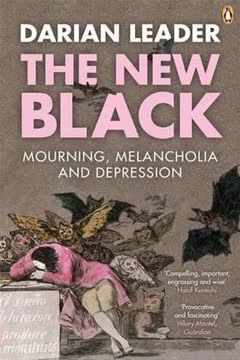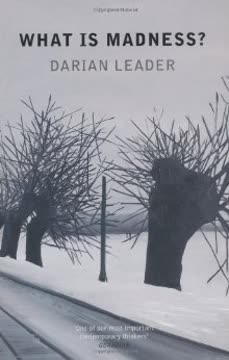Key Takeaways
1. Depression is a Multifaceted Response, Not a Singular Disease
Depression is a vague term for a variety of states.
Beyond Biochemistry. The book challenges the prevailing view of depression as solely a biological problem treatable with medication. It argues that depression is a complex set of symptoms arising from diverse human experiences, particularly those involving loss and separation. Reducing it to a mere chemical imbalance neglects the intricate stories and unconscious mental lives of sufferers.
Social and Economic Factors. The rise of market-driven economies and the breakdown of social support systems contribute to feelings of isolation and depletion, leading to depressive states. This perspective sees depression as a form of protest against the values of efficiency and economic productivity, a refusal to be reduced to a unit of energy in industrialized societies.
Mourning and Melancholia. The author advocates for reviving the concepts of mourning and melancholia to better understand the nuances of human responses to loss. These concepts offer more precise tools for exploring how individuals deal with separation, bereavement, and the inevitable losses that are part of human life, moving beyond the broad and often misused term "depression."
2. Mourning Requires External Validation and Social Rituals
Mourning, I will argue, requires other people.
Private vs. Public Grief. Freud's view of mourning as an individual task is incomplete. Every documented human society gives a central place to public mourning rituals. These rituals, customs, and codes, ranging from changes in dress to memorial ceremonies, involve not just the bereaved individual but the larger social group.
Erosion of Rituals. Modern societies, suspicious of public displays, tend to make grief more and more a private event, the domain of the individual. This erosion of social mourning rites may make mourning more difficult. The absence of a shared, symbolic space for grief can hinder the process of acknowledging and processing loss.
Dialogue of Mournings. The book emphasizes the importance of a "dialogue of mournings," where individuals can access their own grief through the shared experience of others. Public displays of grief, literature, and art provide a framework for articulating and understanding personal losses, offering a sense of validation and connection.
3. Melancholia Involves a Profound Loss of Self-Worth
The melancholic represents himself as ‘poor, worthless and despicable, and expects to be cast out and punished’.
Lowered Self-Regard. Melancholia is distinguished from mourning by a significant lowering of self-regard. The melancholic subject experiences intense self-reproach, self-reviling, and a delusional expectation of punishment. This goes beyond mere feelings of sadness or inadequacy; it involves a deep-seated conviction of worthlessness and a belief that one's very existence is a sin or crime.
Internalized Reproaches. The self-reproaches of the melancholic are, in fact, reproaches directed towards a lost loved one who has been internalized. The anger and hatred directed at the lost person are displaced onto the ego, which is now judged as if it were the forsaken object. The "shadow of the object" falls on the ego, subjecting it to merciless criticism.
Certainty vs. Doubt. Unlike neurotic individuals who may link feelings of unworthiness to specific aspects of their physical image, the melancholic experiences a much deeper complaint. It is the very core of their being which is unworthy or wrong. There is a certainty here rather than doubt.
4. Unresolved Anger Complicates the Mourning Process
Absence is never accepted without rage.
Ambivalence and Loss. The book highlights the role of ambivalence in the mourning process. It is not the intensity of positive feelings towards the lost loved one that is decisive, but rather the mixture of love and hate. Unresolved anger and hostility towards the deceased can significantly impede the work of mourning.
Displaced Anger. Hostility to the dead is not well tolerated, and anger is often displaced onto other targets, such as colleagues, friends, or even medical professionals. This displacement can manifest in various ways, including the emergence of an "enemy" in the bereaved person's circle after a significant loss.
Unconscious Fury. One of the most important discoveries of psychoanalysis is the fact that we can feel fury without being consciously aware of it. This unconscious hostility can emerge in dreams, slips of the tongue, or even acts of violence during sleep, highlighting the complex interplay between affection and hatred in our emotional lives.
5. Identification with the Lost Object Shapes Mourning and Melancholia
In mourning, we grieve the dead; in melancholia, we die with them.
Homeopathy with the Dead. In both mourning and melancholia, individuals identify with the ones they have lost, taking on aspects of their behavior, mannerisms, and even their ways of looking at the world. This "homeopathy with the dead" can manifest in various ways, from mimicking physical symptoms to adopting the interests and pursuits of the deceased.
Melancholic Identifications. In melancholia, the identification with the lost object is pervasive, with the self entirely swallowed up in an identification with the lost loved one. The melancholic might spend their days visiting every place the deceased had visited, looking at the world exclusively from the latter's place.
Building the Ego. Freud believed that our egos are made up of all the leftover traces of our abandoned relationships. Each broken relationship leaves its stamp on us, and our identity is a result of the building up over time of these residues. It's less 'You are what you eat' than 'You are what you've loved.'
6. The Arts Provide a Framework for Processing Loss
The arts in fact be a vital tool in allowing us to make sense of the losses inevitable in all of our lives?
Art as Mourning. The arts serve as a vital tool in allowing us to make sense of the losses inevitable in all of our lives. Literature, theatre, cinema, and the visual arts offer a framework for processing grief, providing models of creation that emerge from the turbulence of human experience.
Identifying with the Creator. We identify not only with the protagonists of works of art but also with the creator, someone who could make something out of an inferred experience of loss. This identification allows us to access grief and find ways to articulate our own experiences of loss.
Emotional Literacy. Rather than imposing a pre-set language on individuals, the arts expose them to a variety of ways of creating, from Shakespeare to Picasso, from J. K. Rowling to Tracey Emin. Children are thus confronted with the ways that individuals have responded in their own unique fashion to the experience of frustration, sadness and loss.
7. Mourning Involves a Shift to a Symbolic Space
In mourning, this reference point is not just removed, but its absence is registered, inscribed indelibly in our mental lives.
Framing the Loss. Mourning involves a shift from the real to the symbolic, a process of "making artificial." This is reflected in the ubiquity of frames, doorways, arches, and stages in the dreams of bereaved people, which serve to divide up space and draw attention to the artificial nature of what is being played out.
Monuments and Memorials. The very principle behind the idea of the monument is that the space cannot be allowed to remain the same as it was before the moment of tragedy and loss. Rather, in order to become memorials, they have to be changed: either through total demolition and then erection of a new structure, or through some alteration or intervention.
Reversal of Conventions. Many cultures have mourning rituals which involve the reversal of established conventions, such as men dressing as women or inverting social hierarchies. By reversing established conventions, these practices illuminate the symbolic, artificial nature of social reality.
8. Killing the Dead is Necessary for Symbolic Closure
One then has the choice of dying oneself or of acknowledging the death of the loved one, which again comes very close to your expression that one kills this person…
Symbolic vs. Biological Death. Mourning involves not just acknowledging biological death but also achieving symbolic closure. This often requires a symbolic "killing of the dead," a process of banishing and keeping at bay the restless spirits of the departed.
Death-Wishes and Guilt. The book explores the role of death-wishes and guilt in the mourning process. Unconscious hostilities towards the lost loved one can complicate mourning, leading to feelings of guilt and self-reproach.
Cultural Rituals. Many cultures have rituals that address the need to manage death-wishes and guilt, ranging from "comedies of innocence" that shift blame away from the bereaved to rituals of punishment that externalize feelings of guilt. These rituals serve to protect the mourner from their own self-reproaches.
9. Loyalty to the Dead Can Hinder New Attachments
We will never find a substitute [after a loss]. No matter what may fill the gap, even if it be filled completely, it nevertheless remains something else.
Conflicting Loyalties. A problem occurs when a pervasive sense of loyalty to the dead prevents any expression of ties to the living. This loyalty may be rooted in guilt feelings, with the mourner feeling an overpowering sense of owing something to the deceased.
Dimensions of Debt. The book distinguishes between two forms of debt: those that can be repaid and those that cannot. Confusing these two dimensions can lead to a severe disturbance in the mourning process, with the mourner feeling that they can neither pay nor leave the debt unpaid.
Symbolic Sacrifices. Mourning involves a certain sacrifice, a voluntary giving-up of something dear to us. This may take the form of a lock of hair or some other object thrown into the grave, symbolizing the mourner's consent to the loss and their willingness to move forward.
10. The Melancholic Impasse: A Blocked Symbolic Order
In mourning, we grieve the dead; in melancholia, we die with them.
Two Worlds. The melancholic subject is in two places at once, two entirely different spaces that cannot be superimposed. This split existence can lead to the feeling that the living are not really alive, with the melancholic viewing others as empty husks or unreal shadows.
Symbolic Impasse. At the heart of melancholia is a symbolic impasse, a difficulty in accessing word representations through thing representations. The melancholic is left in a limbo, unable to fully integrate their experience of loss into a coherent narrative.
The Call of the Dead. The melancholic's loyalty to the dead is so strong that they may choose to join them literally, through suicide. This is not simply a desire to escape pain but a fundamental inability to relinquish the attachment to the lost loved one and the world they represent.
Last updated:
FAQ
1. What is "The New Black: Mourning, Melancholia and Depression" by Darian Leader about?
- Explores Depression and Loss: The book examines how contemporary society understands and treats depression, contrasting it with the psychoanalytic concepts of mourning and melancholia.
- Critique of Medicalization: Leader critiques the modern tendency to medicalize depression, arguing that it often overlooks the complex psychological and social roots of suffering.
- Reviving Old Concepts: The author advocates for a return to Freud’s distinctions between mourning (the process of working through loss) and melancholia (a pathological response to loss), suggesting these offer deeper insight than the blanket term "depression."
- Role of Society and Creativity: The book also investigates the social dimensions of grief, the erosion of public mourning rituals, and the role of art and creativity in processing loss.
2. Why should I read "The New Black" by Darian Leader?
- Deeper Understanding of Depression: The book provides a nuanced perspective on depression, moving beyond simplistic biological explanations to consider unconscious processes and personal histories.
- Insight into Grief and Mourning: Readers gain a richer understanding of how mourning and melancholia differ, and why these distinctions matter for mental health and healing.
- Critical of Modern Treatments: Leader offers a thoughtful critique of current psychiatric and psychological treatments, especially the dominance of medication and cognitive-behavioral therapy.
- Practical and Reflective: The book encourages readers to reflect on their own experiences of loss and to consider the importance of community, ritual, and creativity in recovery.
3. What are the key takeaways from "The New Black" by Darian Leader?
- Depression Is Not One-Size-Fits-All: Depression is a vague term covering a range of experiences, and understanding individual stories is crucial.
- Mourning vs. Melancholia: Mourning is a process of working through loss, while melancholia involves a pathological identification with the lost object, often resulting in self-reproach and guilt.
- Importance of Social Rituals: The decline of public mourning rituals has made grief more isolating and potentially more difficult to resolve.
- Role of Creativity and Art: Engaging with art and creativity can be a vital tool in processing loss and making sense of suffering.
4. How does Darian Leader define and differentiate "mourning" and "melancholia" in "The New Black"?
- Mourning: Defined as the conscious process of detaching from a lost loved one, involving the gradual acceptance of their absence and the eventual ability to invest in new relationships or pursuits.
- Melancholia: Characterized by unconscious identification with the lost object, leading to self-reproach, feelings of worthlessness, and a sense of being condemned or guilty.
- Key Difference: In mourning, the loss is recognized and processed; in melancholia, the loss is internalized and the self becomes the site of the lost object’s reproach.
- Clinical Implications: Mourning can be blocked by unresolved ambivalence or hatred, while melancholia often manifests as a persistent, pathological state resistant to resolution.
5. What is Darian Leader’s critique of modern approaches to depression in "The New Black"?
- Over-Medicalization: Leader argues that depression is too often treated as a purely biological disorder, neglecting the psychological and social dimensions of suffering.
- Surface-Level Treatments: He criticizes the dominance of short-term, symptom-focused therapies like CBT, which may not address underlying unconscious conflicts or the meaning of symptoms.
- Pharmaceutical Industry Influence: The book highlights how drug companies have shaped both the definition of depression and its treatment, often prioritizing profit over patient well-being.
- Neglect of Individual Stories: Modern approaches tend to ignore the unique personal histories and losses that give rise to depressive states.
6. How does "The New Black" by Darian Leader explain the role of society and public rituals in mourning?
- Erosion of Public Mourning: Leader discusses how traditional mourning rituals and public displays of grief have declined in Western societies, making grief a more private and isolating experience.
- Social Validation of Loss: Public rituals help individuals process loss by providing communal recognition and validation, which can be essential for healthy mourning.
- Consequences of Isolation: The lack of social support and ritual can lead to unresolved or pathological grief, as individuals struggle to symbolize and integrate their losses.
- Dialogue of Mournings: The book emphasizes the importance of sharing grief with others, suggesting that exposure to others’ mourning can help individuals process their own.
7. What are the four key processes of mourning described in "The New Black" by Darian Leader?
- Introduction of a Frame: Creating a symbolic or artificial space (such as a ritual or monument) to mark and contain the loss.
- Killing the Dead: Symbolically laying the dead to rest, which may involve acknowledging ambivalent feelings and separating from the lost object.
- Constitution of the Object: Differentiating between the image of the loved one and the place they occupied in one’s psyche, allowing for new attachments.
- Giving Up the Image of Who We Were for Them: Mourning not just the lost person, but also the identity and role we held in relation to them.
8. How does "The New Black" by Darian Leader address the relationship between creativity, art, and mourning?
- Art as Mourning Tool: Leader suggests that engaging with art and creativity can help individuals process and symbolize loss, offering models for creation out of absence.
- Dialogue with Artists: The book discusses how exposure to the mourning processes of artists and writers can facilitate personal mourning in others.
- Making Absence Present: Artistic creation often involves framing or representing absence, paralleling the psychological work of mourning.
- Encouragement to Create: Leader advocates for personal creative expression as a way to work through grief and find meaning after loss.
9. What clinical examples and case studies does Darian Leader use in "The New Black" to illustrate his ideas?
- Personal Stories: The book includes numerous clinical vignettes, such as individuals who develop depression after achieving a long-sought goal or after a significant loss.
- Dream Analysis: Leader uses dreams reported by patients to illustrate the unconscious processes at work in mourning and melancholia.
- Historical and Literary Cases: The book references figures like Queen Victoria, Joan Didion, and artists such as Sophie Calle to show how mourning and melancholia manifest in different contexts.
- Childhood Loss: Several cases explore how early losses or disruptions in caregiving can shape later experiences of depression and grief.
10. How does "The New Black" by Darian Leader critique cognitive-behavioral therapy (CBT) and other short-term psychological treatments?
- Focus on Surface Symptoms: Leader argues that CBT targets observable behaviors and thoughts, often ignoring the deeper, unconscious roots of suffering.
- Lack of Individualization: CBT tends to apply standardized protocols, which may not address the unique personal history and meaning of each person’s depression.
- Short-Term Results: While CBT may produce quick improvements on paper, it may not prevent the recurrence of symptoms or address underlying issues.
- Contrast with Psychoanalysis: The book advocates for psychoanalytic approaches that prioritize listening, dialogue, and exploration of unconscious processes.
11. What is the significance of the concepts of "identification" and "ambivalence" in "The New Black" by Darian Leader?
- Identification with the Lost Object: In melancholia, the individual unconsciously identifies with the lost person, turning anger and reproach inward.
- Ambivalence in Relationships: Leader emphasizes that love and hate are always mixed in close relationships, and unresolved ambivalence can block mourning.
- Clinical Consequences: Failure to acknowledge ambivalent feelings can lead to pathological mourning or melancholia, manifesting as guilt, self-reproach, or even physical symptoms.
- Role in Healing: Recognizing and working through identification and ambivalence is essential for successful mourning and recovery from depression.
12. What are the best quotes from "The New Black" by Darian Leader and what do they mean?
- "In mourning, we grieve the dead; in melancholia, we die with them." – This highlights the crucial difference between healthy mourning (processing loss) and melancholia (pathological identification with the lost object).
- "Depression is a vague term for a variety of states. Mourning and melancholia, however, are more precise concepts that can help shed light on how we deal – or fail to deal – with the losses that are part of human life." – Leader argues for the importance of nuanced understanding over catch-all diagnoses.
- "The arts exist to allow us to access grief, and they do this by showing publicly how creation can emerge from the turbulence of a human life." – This quote underscores the therapeutic and communal value of art in processing loss.
- "We must be careful, however, not to confuse these two structures. A difficult, protracted mourning is not the same thing as a melancholia. In mourning, we slowly detach ourselves from the dead. In melancholia, we attach ourselves to them." – Leader warns against conflating prolonged grief with the more severe, self-destructive state of melancholia.
- "Truth, he said, is never the same as the ‘facts’." – This reflects the book’s emphasis on the subjective, personal truth of suffering, which cannot always be captured by objective measures or diagnostic criteria.
Review Summary
The New Black receives mostly positive reviews for its insightful exploration of mourning, melancholia, and depression through a psychoanalytic lens. Readers appreciate Leader's clear explanations, use of clinical examples, and incorporation of art and literature. The book is praised for its thought-provoking content and accessible approach to complex psychological concepts. Some reviewers find the middle sections more technical, while others note the book's focus on mourning rather than depression. Overall, readers find the book enlightening and valuable for understanding grief and loss.
Download PDF
Download EPUB
.epub digital book format is ideal for reading ebooks on phones, tablets, and e-readers.








